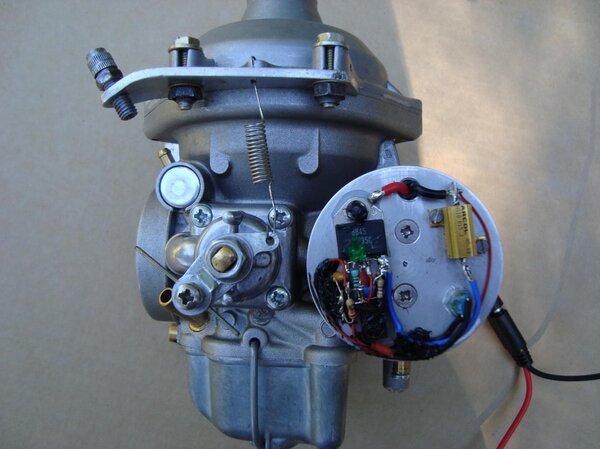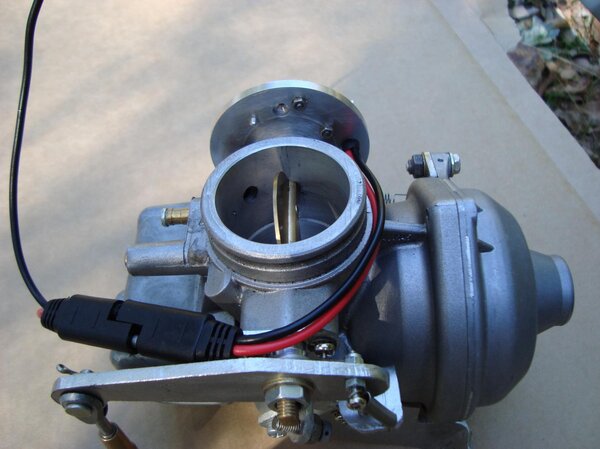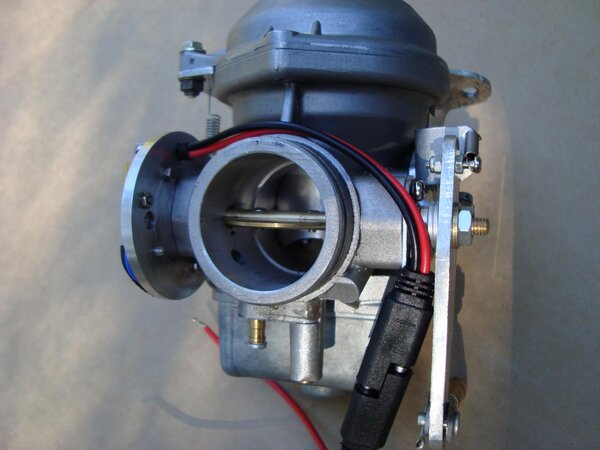
davemac
Members-
Posts
10 -
Joined
-
Last visited
Content Type
Profiles
Forums
Gallery
Downloads
Blogs
Events
Store
Aircraft
Resources
Tutorials
Articles
Classifieds
Movies
Books
Community Map
Quizzes
Everything posted by davemac
-
Welcome Fred, last time we spoke it was to be a Pietenpol but I like that Spacewalker 11, davemac, Funk R2800
-
Shown without the cover, the base plate was sized to take the lid of a spray paint can. the unit screws onto the butterfly boss for heat transfer to the carb body around the butterfly. The transistor dumps its heat into the base plate which acts as a heat accumulator. Since the unit cycles at around 20C, it is a 'switch on and forget' jobbie. I have a small LED that comes on with the cycling power as a confidence light. I have flown it for 6 hours now but since I have not been in icing conditions to my knowledge, I cannot really say if it disperses ice. Similar units with the resistor referred to to in the original post, are in use in Canada and Europe, so I figure the concept of a warm butterfly is sound.
-
Hi Y'All, I built a similar unit for my Rotec R2800. I used a Hi Power transisitor switched by a thermistor that turns Off about 20 deg C. The heat source is the heatsink for the transistor; total cost about $40. I was not happy with a resistor heating all the time with no temperature control. I tested it by cold soaking the Bing in a freezer to about -5C, then turning on the anti-ice, with the unit still in the freezer. The butterfly came up to +2c within a minute and then climbed about 5 C every minute until it hit the thermistor value of 20C where it cycled On and OFF between 18 and 20 C. The unit is about 50mm in Dia and 20mm thick, it draws about 2 amp continuous (30 watts), 5 amp max(70watts) on turn on. I connected it through a switched CB rated at 10 amp. BR davemac
-
At airports, the fuel pump has an earth lead.
davemac replied to flying dog's topic in AUS/NZ General Discussion
Hi Gomer, the earth wire applied before fuelling aircraft has two purposes, it dissipates static electric charges built up on the skin due to the air rushing past it in flight, and static charge also build up during the fuel operation itself by the fuel rushing along the hose. This is why the aircraft is 'earthed' to ground and "earthed" to the bowser. No electric potential difference anywhere. In days gone by, this whole operation may been have carried out on a totally grassed surface, often a poor conductor. The conductive hose in servos is only considered for static buildup during the fuelling operation as the initial action of opening the tank cap will 'earth' out the tank via the person standing on the ground doing the refuelling. But, I must admit, I have often thought of that zap I get, as I put the key in the car door after walking across from a shop with a carpeted floor. I seem to get the biggest zap when returning from my local Dick Smith! After re-reading your post yet again, this is pretty much what you have already said, but my take on it may help another reader to see it more clearly. -
At airports, the fuel pump has an earth lead.
davemac replied to flying dog's topic in AUS/NZ General Discussion
Filling 200 lt drums at servos has been banned for a few years as, supposedly they may not be earthed. But how is your car's petrol tank earthed? Through the hose is the answer, carbon filled rubber hose, and this by the nozzle touching the petrol filler neck. So if you keep the filler nozzle in contact with the 200 lt drum neck, then it is earthed; if you break this contact intermittently, like shaking the nozzle, you could cause a static discharge, ie, a spark. This was the supposed reason that a lady set fire to her car when filling a jerry can recently; apparently she stopped the fill, removed the nozzle to check how much was in the can, and up it went! I have tried to fill a 200 lt drum in my ute with a proper earth line connected back to the bowser but the console operater does not understand the theory and just says No. How the hell one lifts a full 200 lt drum back into a ute at a servo is beyond me! I just use metal jerry cans at the servo, filled on the ground, and lifted into the ute when full. -
Has anybody fitted the new Microair M760 Rev Q comm in their aircraft
davemac replied to a topic in Engines and Props
I have a Microair rev P in my Funk, It has perfomed perfectly for 2 years now and the built in I/C also works well. I have a friend who fitted a Xcom to an RV and had endless trouble with noise and interference and lots of hassles with warranty. Give me Microair any day. davemac ;) -
Hi Pud, further to my last, the Rotec has 100hp at 3300 rpm, it is a geared engine so prop speed is 2/3 of that. It fairly leaps off the mark and cruises about 100 mph with no engine cowl, 10 mph up on the old C85. I expect a bit more when I fit the new cowl. The new freeway cuts about 10 minutes off my journey from Mundaring to Serpentine to about an even hour. I looked seriously at moving to Northam, about 30 minutes from me, a couple of years back but when the new freeway was proposed I delayed until I tried it. 10 years ago it would take an hour and a half for the journey. BR, davemac
-
Hi Pud, the pre war Funks had inverted 4 cyl Ford car engines fitted with Al/alloy heads and variable ignition which gave them about 55hp at 2400 rpm. The planes were OK, albeit a little slow on T/O. Pioneer Airfield, at OSHKOSH, has one of these in perfect condition on display. WW2 came along and Funk brothers were involved in making parts for WACO gliders and other planes.The Funk brothers did make a few planes on the quiet, during these years but as it was wartime, no details are available. !946 saw the boom time for light aircraft and Funk brothers sold about 370 planes in '46 and '47. Most were fitted with war surplus Continental C85, Lycoming O145 and the rarer Franklin 4A4 90 hp engine. Funk sold only 22 airplanes in '48. You could buy a Funk in '48 for $1500 that would have cost $3995 a year before! Funks were for sale in car yards in 1948, "make me an offer!" My bird is #335, built in Sep 46. I was born in Mar 46 The Funk brothers went into making implements for Ferguson and Ford tractors until they sold out to John Deere in the 70s. The factory building is still in Coffeyville Kansas; the last of the Funk brothers, Joe, died in Coffeyville in 2003 I made a rubber powered model Funk in 1958 when i was 12 years old, and have loved the bird ever since. Imagine my joy when I found one on barnstormers.com in Tennessese owned by an old enthusiast who had it for 20 years. I bought it online and travelled to TN and flew it down to Alabama to a private field, pulled the wings off and put it in a box and sent it to Fremantle. I put it on the RAA register in 2008, flew it fo a few hours with the C85 and decided that it needed a Rotec radial. I flew the Funk with the R2800 2 weeks ago and it is a perfect fit. Just for interest, the Funk brothers tried a 45 hp Szcekely radial in their plane in 1936, but was underpowered so they went for the Ford B model engine. Any queries most welcome; Davemac
-
funk Yeah, get that a bit and in a blue Funk, and funk off! :uhoh2:
-
Hi all, I fly a 1946 Funk B fitted with a Rotec2800 radial out of Serpentine WA. I am currently making a full engine cowl. I am a member of the Sport Aircraft Builders Club and our annual fly-in is on this Sunday, Sep26.



